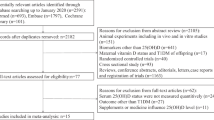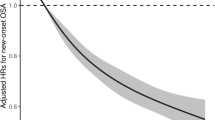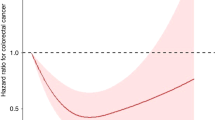Abstract
Background/Objectives:
The aim was to examine the causal effect of vitamin D on serum adiponectin using a multiple instrument Mendelian randomization approach.
Subjects/Methods:
Serum 25-hydroxy vitamin D (25(OH)D) and serum total or high molecular weight (HMW) adiponectin were measured in two Danish population-based studies: the Inter99 study (6405 adults, 30–60 years) conducted in 1999–2001, and the MONICA10 study (2656 adults, 41–71 years) conducted in 1993–1994.
Results:
In the Inter99 study, serum 25(OH)D was positively associated with total adiponectin (the effect estimate in % per doubling of 25(OH)D was 4.78, 95% CI: 1.96, 7.68, P<0.001). Using variations in the vitamin D-binding protein gene and the filaggrin gene as instrumental variables, the causal effect in % was estimated to 61.46, 95% CI: 17.51, 120.28, P=0.003 higher adiponectin per doubling of 25(OH)D. In the MONICA10 cohort, no significant association was observed between the serum concentrations of 25(OH)D and HMW adiponectin (the effect estimate in % per doubling of 25(OH)D was −1.51, 95% CI: −5.80, 2.98, P=0.50), although the instrumental variables analysis to some extent supported a positive causal association (the effect estimate in % per doubling of 25(OH)D was 37.13, 95% CI: −3.67, 95.20, P=0.080).
Conclusions:
The results indicate a possible causal association between serum 25(OH)D and total adiponectin. However, the association was not replicated for HMW adiponectin. Thus, further studies are needed to confirm a causal relationship.
This is a preview of subscription content, access via your institution
Access options
Subscribe to this journal
Receive 12 print issues and online access
$259.00 per year
only $21.58 per issue
Buy this article
- Purchase on SpringerLink
- Instant access to full article PDF
Prices may be subject to local taxes which are calculated during checkout
Similar content being viewed by others
References
Husemoen L, Thuesen B, Fenger M, Jorgensen T, Glümer C, Svensson J et al. Serum 25(OH)D and type 2 diabetes association in a general population: a prospective study. Diabetes Care 2012; 35: 1695–1700.
Husemoen LL, Skaaby T, Thuesen BH, Jorgensen T, Fenger RV, Linneberg A . Serum 25(OH)D and incident type 2 diabetes: a cohort study. Eur J Clin Nutr 2012; 66: 1309–1314.
Alvarez JA, Ashraf A . Role of vitamin d in insulin secretion and insulin sensitivity for glucose homeostasis. Int J Endocrinol 2010; 2010: 351385.
Mathieu C, Gysemans C, Giulietti A, Bouillon R . Vitamin D and diabetes. Diabetologia 2005; 48: 1247–1257.
Simpson F, Whitehead JP . Adiponectin—it's all about the modifications. Int J Biochem Cell Biol 2010; 42: 785–788.
Goldstein BJ, Scalia R . Adiponectin: a novel adipokine linking adipocytes and vascular function. J Clin Endocrinol Metab 2004; 89: 2563–2568.
Li S, Shin HJ, Ding EL, Van Dam RM . Adiponectin levels and risk of type 2 diabetes: a systematic review and meta-analysis. JAMA 2009; 302: 179–188.
Dastani Z, Hivert MF, Timpson N, Perry JR, Yuan X, Scott RA et al. Novel loci for adiponectin levels and their influence on type 2 diabetes and metabolic traits: a multi-ethnic meta-analysis of 45,891 individuals. PLoS Genet 2012; 8: e1002607.
Wang Y, Lam KS, Yau MH, Xu A . Post-translational modifications of adiponectin: mechanisms and functional implications. Biochem J 2008; 409: 623–633.
Neumeier M, Weigert J, Schaffler A, Wehrwein G, Muller-Ladner U, Scholmerich J et al. Different effects of adiponectin isoforms in human monocytic cells. J Leukoc Biol 2006; 79: 803–808.
Barb D, Williams CJ, Neuwirth AK, Mantzoros CS . Adiponectin in relation to malignancies: a review of existing basic research and clinical evidence. Am J Clin Nutr 2007; 86: s858–s866.
Vaidya A, Forman JP, Underwood PC, Hopkins PN, Williams GH, Pojoga LH et al. The influence of body mass index and renin-angiotensin-aldosterone system activity on the relationship between 25-hydroxyvitamin D and adiponectin in Caucasian men. Eur J Endocrinol 2011; 164: 995–1002.
Vaidya A, Williams JS, Forman JP . The independent association between 25-hydroxyvitamin D and adiponectin and its relation with BMI in two large cohorts: the NHS and the HPFS. Obesity (Silver Spring) 2012; 20: 186–191.
Nimitphong H, Chanprasertyothin S, Jongjaroenprasert W, Ongphiphadhanakul B . The association between vitamin D status and circulating adiponectin independent of adiposity in subjects with abnormal glucose tolerance. Endocrine 2009; 36: 205–210.
Mazloomi S, Sharifi F, Hajihosseini R, Kalantari S, Mazloomzadeh S . Association between hypoadiponectinemia and low serum concentrations of calcium and vitamin d in women with polycystic ovary syndrome. ISRN Endocrinol 2012; 2012: 949427.
Parikh S, Guo DH, Pollock NK, Petty K, Bhagatwala J, Gutin B et al. Circulating 25-hydroxyvitamin D concentrations are correlated with cardiometabolic risk among American black and white adolescents living in a year-round sunny climate. Diabetes Care 2012; 35: 1133–1138.
Teles FR, Teles RP, Martin L, Socransky SS, Haffajee AD . Relationships among interleukin-6, tumor necrosis factor-alpha, adipokines, vitamin D, and chronic periodontitis. J Periodontol 2012; 83: 1183–1191.
Davey SG, Ebrahim S . 'Mendelian randomization': can genetic epidemiology contribute to understanding environmental determinants of disease? Int J Epidemiol 2003; 32: 1–22.
Smith GD, Ebrahim S . Mendelian randomization: prospects, potentials, and limitations. Int J Epidemiol 2004; 33: 30–42.
Wang TJ, Zhang F, Richards JB, Kestenbaum B, van Meurs JB, Berry D et al. Common genetic determinants of vitamin D insufficiency: a genome-wide association study. Lancet 2010; 376: 180–188.
Ahn J, Yu K, Stolzenberg-Solomon R, Simon KC, McCullough ML, Gallicchio L et al. Genome-wide association study of circulating vitamin D levels. Hum Mol Genet 2010; 19: 2739–2745.
Thyssen JP, Thuesen B, Huth C, Standl M, Carson CG, Heinrich J et al. Skin barrier abnormality caused by filaggrin (FLG) mutations is associated with increased serum 25-hydroxy vitamin D concentrations. J Allergy Clin Immunol 2012; 130: 1204–1207.
Jorgensen T, Borch-Johnsen K, Thomsen TF, Ibsen H, Glumer C, Pisinger CA . Randomized non-pharmacological intervention study for prevention of ischaemic heart disease: baseline results Inter99. Eur J Cardiovasc Prev Rehabil 2003; 10: 377–386.
Husemoen LL, Jorgensen T, Borch-Johnsen K, Hansen T, Pedersen O, Linneberg A . The association of alcohol and alcohol metabolizing gene variants with diabetes and coronary heart disease risk factors in a white population. PLoS One 2010; 5: e11735.
Kolberg JA, Jorgensen T, Gerwien RW, Hamren S, McKenna MP, Moler E et al. Development of a type 2 diabetes risk model from a panel of serum biomarkers from the Inter99 cohort. Diabetes Care 2009; 32: 1207–1212.
Turer AT, Scherer PE . Adiponectin: mechanistic insights and clinical implications. Diabetologia 2012; 55: 2319–2326.
Mather KJ, Funahashi T, Matsuzawa Y, Edelstein S, Bray GA, Kahn SE et al. Adiponectin, change in adiponectin, and progression to diabetes in the Diabetes Prevention Program. Diabetes 2008; 57: 980–986.
Goldfine AB, Gerwien RW, Kolberg JA, O'Shea S, Hamren S, Hein GP et al. Biomarkers in fasting serum to estimate glucose tolerance, insulin sensitivity, and insulin secretion. Clin Chem 2011; 57: 326–337.
Thuesen B, Husemoen L, Fenger M, Jakobsen J, Schwarz P, Toft U et al. Determinants of vitamin D status in a general population of Danish adults. Bone 2012; 50: 605–610.
Carter GD, Carter R, Jones J, Berry J . How accurate are assays for 25-hydroxyvitamin D? Data from the international vitamin D external quality assessment scheme. Clin Chem 2004; 50: 2195–2197.
Meldgaard M, Szecsi PB, Carlsen BC, Thyssen JP, Johansen JD, Menne T et al. A novel multiplex analysis of filaggrin polymorphisms: a universally applicable method for genotyping. Clin Chim Acta 2012; 413: 1488–1492.
Kezic S, O'Regan GM, Yau N, Sandilands A, Chen H, Campbell LE et al. Levels of filaggrin degradation products are influenced by both filaggrin genotype and atopic dermatitis severity. Allergy 2011; 66: 934–940.
Obesity: preventing and managing the global epidemic. Report of a WHO consultation 2004, Geneva World Health Orginazation, Ref Type: Report.
Toft U, Kristoffersen LH, Lau C, Borch-Johnsen K, Jorgensen T . The Dietary Quality Score: validation and association with cardiovascular risk factors: the Inter99 study. Eur J Clin Nutr 2007; 61: 270–278.
Osler M, Heitmann BL, Gerdes LU, Jorgensen LM, Schroll M . Dietary patterns and mortality in Danish men and women: a prospective observational study. Br J Nutr 2001; 85: 219–225.
Palmer TM, Lawlor DA, Harbord RM, Sheehan NA, Tobias JH, Timpson NJ et al. Using multiple genetic variants as instrumental variables for modifiable risk factors. Stat Methods Med Res 2012; 21: 223–242.
Pierce BL, Ahsan H, Vanderweele TJ . Power and instrument strength requirements for Mendelian randomization studies using multiple genetic variants. Int J Epidemiol 2011; 40: 740–752.
Glymour MM, Tchetgen EJ, Robins JM . Credible Mendelian randomization studies: approaches for evaluating the instrumental variable assumptions. Am J Epidemiol 2012; 175: 332–339.
Theodoratou E, Palmer T, Zgaga L, Farrington SM, McKeigue P, Din FV et al. Instrumental variable estimation of the causal effect of plasma 25-hydroxy-vitamin D on colorectal cancer risk: a mendelian randomization analysis. PLoS One 2012; 7: e37662.
Burgess S . Re: 'credible mendelian randomization studies: approaches for evaluating the instrumental variable assumptions’. Am J Epidemiol 2012; 176: 456–457.
Liu E, Meigs JB, Pittas AG, McKeown NM, Economos CD, Booth SL et al. Plasma 25-hydroxyvitamin d is associated with markers of the insulin resistant phenotype in nondiabetic adults. J Nutr 2009; 139: 329–334.
Vilarrasa N, Vendrell J, Maravall J, Elio I, Solano E, San JP et al. Is plasma 25(OH) D related to adipokines, inflammatory cytokines and insulin resistance in both a healthy and morbidly obese population? Endocrine 2010; 38: 235–242.
Gannage-Yared MH, Chedid R, Khalife S, Azzi E, Zoghbi F, Halaby G . Vitamin D in relation to metabolic risk factors, insulin sensitivity and adiponectin in a young Middle-Eastern population. Eur J Endocrinol 2009; 160: 965–971.
Heidemann C, Sun Q, Van Dam RM, Meigs JB, Zhang C, Tworoger SS et al. Total and high-molecular-weight adiponectin and resistin in relation to the risk for type 2 diabetes in women. Ann Intern Med 2008; 149: 307–316.
Nakashima R, Kamei N, Yamane K, Nakanishi S, Nakashima A, Kohno N . Decreased total and high molecular weight adiponectin are independent risk factors for the development of type 2 diabetes in Japanese-Americans. J Clin Endocrinol Metab 2006; 91: 3873–3877.
Sun X, Zemel MB . Calcium and 1,25-dihydroxyvitamin D3 regulation of adipokine expression. Obesity (Silver Spring) 2007; 15: 340–348.
Acknowledgements
This work was supported by grants from the Health Insurance Foundation (grant No. 2010 B 131), the Danish Agency for Science Technology and Innovation (grant No. 2101-06-0065) and the Region H Research Foundation. The authors wish to thank the Inter99 Steering Committee (Dr Torben Jørgensen (principal investigator), Dr Knut Borch-Johnsen (co-principal investigator) and Dr Charlotta Pisinger and all the members of the Inter99 staff at the Research Centre for Prevention and Health and Steno Diabetes Center.
Author information
Authors and Affiliations
Corresponding author
Ethics declarations
Competing interests
The authors declare no conflict of interest.
Additional information
Supplementary Information accompanies this paper on European Journal of Clinical Nutrition website
Rights and permissions
About this article
Cite this article
Husemoen, L., Skaaby, T., Martinussen, T. et al. Investigating the causal effect of vitamin D on serum adiponectin using a mendelian randomization approach. Eur J Clin Nutr 68, 189–195 (2014). https://doi.org/10.1038/ejcn.2013.233
Received:
Revised:
Accepted:
Published:
Issue date:
DOI: https://doi.org/10.1038/ejcn.2013.233
Keywords
This article is cited by
-
The causal role of circulating vitamin D concentrations in human complex traits and diseases: a large-scale Mendelian randomization study
Scientific Reports (2021)
-
Relationship of serum Vitamin D concentrations with Adipokines and Cardiometabolic risk among non-Hispanic black type 2 diabetic and non-diabetic subjects: a cross-sectional study
BMC Nutrition (2018)
-
Vitamin-D concentrations, cardiovascular risk and events - a review of epidemiological evidence
Reviews in Endocrine and Metabolic Disorders (2017)
-
Vitamin D and cardiovascular disease prevention
Nature Reviews Cardiology (2016)



